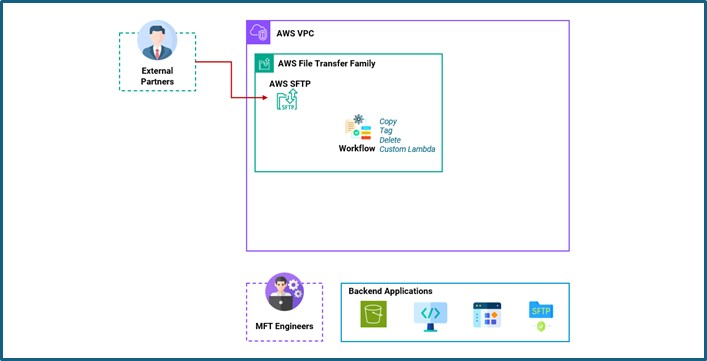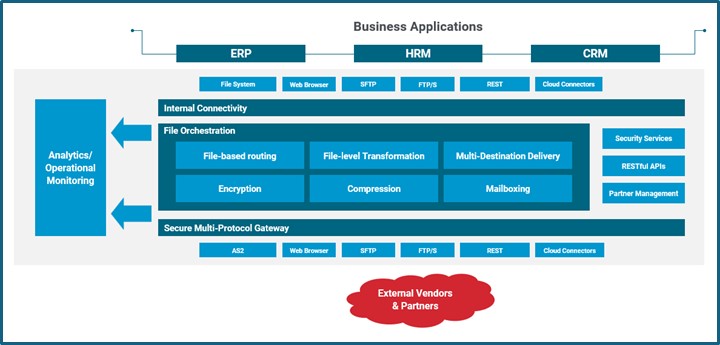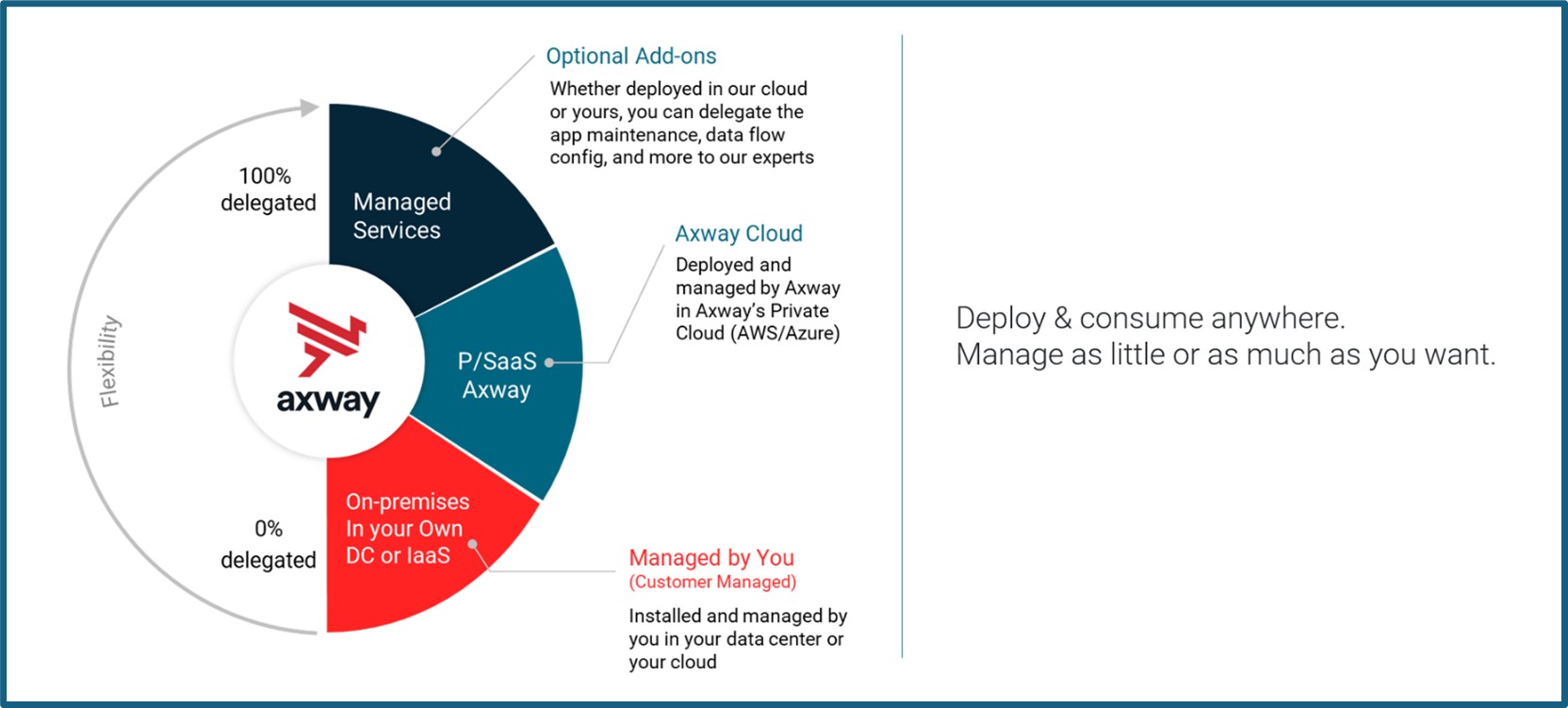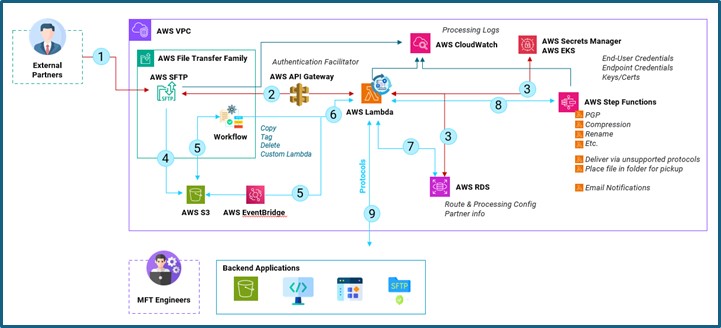The landscape of managed file transfer (MFT) services is evolving rapidly with the growing adoption of cloud solutions. AWS Transfer Family and Axway MFT are prominent solutions in this space.
Axway maintains a close strategic technology alliance with AWS for our managed cloud services, and we run hundreds of customer gateway implementations in AWS. Axway is also an AWS Advanced Technology Partner, one of seven partners globally (out of a 100,000-partner ecosystem) with dual competency in healthcare and life sciences, in addition to offering our solutions and services in the AWS Marketplace.
But as happens with many larger companies in the enterprise software market, we’re sometimes perceived as competitors in the file transfer space. We’ve had customers wonder why they wouldn’t just use AWS file transfer capabilities for file transfer, given that AWS already stores their data in the cloud. Axway MFT and AWS Transfer Family are not directly comparable, though, as they both cover different scopes.
In short: AWS Transfer Family has a very tactical, developer-focused purpose, but doesn’t address more comprehensive needs of enterprise-level file transfer operations. Here’s why Axway MFT offers robust features that meet the most demanding requirements of modern organizations.
AWS Transfer Family: a closer look

What’s included
- SFTP/FTPS/AS2 server hosting
- Basic post-upload workflow options: Copy, Tag, Delete, Archive, Custom Lambda code
Benefits
- Fully-managed SFTP/FTPS/AS2 server with high availability and zero downtime
- Native cloud storage like S3 for file repository
Strengths
- Ideal for simple cloud-native storage file transfers.
- Example:
- Partner > AWS Transfer S3 > S3 App
- S3 App > S3 App
Weaknesses
- Not suitable for mixed cloud and on-premises environments.
- Lacks basic MFT processing features (encoding, PGP, renaming, compression).
Axway Managed File Transfer: a closer look

What’s included
- Multiple server and client protocols
- Cloud connectors
- Comprehensive, no-code, UI-based file orchestration configuration
- No-code file transformation: PGP, Un/Zip, Renaming, Encoding, Character Replacement, and many more
- Centralized partner and access management
- RESTful APIs for automation, self-service, and external administration
- Centralized logging and visibility of all processing and file transfers
Benefits
- True wholistic zero downtime architecture
- No cloud engineers doing low-value work (setups)
- Wholistic vendor support
- Enterprise features and use case coverage built-in
- Central control of MFT configuration
- No coding, no development, no unexpected costs
- Focus on your business operations, not AWS services
- Not tied to a cloud provider
Strengths
- Enterprise-wide file transfer and use case coverage
- Fully flexible Axway cloud offering

Weaknesses
- Although Axway MFT has an extensible framework to add custom processing steps, protocols, authentication, and more, it requires coding. However, most customers rarely need this due to the completeness of capabilities included out-of-the-box.
Let’s build it anyway; what’s missing?
Let’s say you want to custom-build your MFT using the underlying AWS services. What would it take to replicate just the basics?

With AWS Transfer Family, you are provided with a fully managed protocol server and connectors to exchange files with your MFT ecosystem.
- Authentication: If you need password authentication, you must build it using an API gateway, Lambda code, and a combination of AWS Secrets Manager, EKS, or a Database. You can use local AWS Transfer Family authentication if you need Key-based authentication (SSH Key). Suppose you need both password and key-based authentication. In that case, your authentication is now scattered across the AWS Transfer Family service and EKS/Secrets Manager, and you’ll need Lambda code, API Gateway and DB to piece it together.
- Authorization: You must prevent users from accessing other user directories. The directories and permissions must be housed in a DB schema you define and maintain.
- Storage: AWS S3 or EFS can be used for storage. Both have pros and cons, which we won’t cover here. The main thing to consider is data residency and privacy between various lines of business. This might require you to mount many storage systems, which can make authorization even more complex.
- File Processing Execution: AWS Transfer Family provides copy, tag, delete and calling custom lambda code as part of post-upload workflow steps. Clearly there is plenty missing and using this workflow component prevents other types of use cases, like trigger-based routing. Instead, you’ll need to employ another AWS service like EventBridge to kick off the file processing.
- File Evaluation: To route and process files according to business requirements, you’ll need to call a sequence of Lambda code services. This means developing custom code to handle processing like PGP, compression, decompression, renaming, encoding, and several more. Coding these processing steps to be dynamic and reusable requires advanced coding and maintenance.
- File Orchestration: You coded all the reusable processing steps and placed them in Lambda services. Now, you need to figure out how to define the sequence of those steps. In our study, you’ll need a DB service and careful designing of 20 to 30 tables at minimum. You’ll also need to build an interface with rules to manage the table entries – we won’t cover that here as that is extensive.
- File Processing: Once a processing sequence has been identified, you’ll need to call the various step functions using a custom-defined state machine that calls lambda code services in order. This state machine must have extensive fault logic to process the file according to successful or failed steps.
- File Delivery: To deliver the file you have various options. You can call the AWS Transfer Family connectors to push a file to an endpoint via AS2 or SFTP. If another protocol is needed, you’ll need to use a custom lambda code service to take care of this step.
You’ve now built an MFT solution that addresses the basics. You’ve invested much more and ended up with much less. The truth is that you’re still missing critical components.
See also: the case for not building home-grown MFT
Additional considerations to evaluate a file transfer solution
Runtime
Performance and scalability
- AWS Transfer Family: Fully managed, AWS will scale protocol-server-based (SFTP) resources to accommodate volume/traffic
- Axway MFT: Horizontal scaling up to 20 nodes. A four-node cluster can process 80M files per month. Container deployment provides auto-scaling.
Availability
- AWS Transfer Family: A multi-AZ deployment of protocol servers. Only the protocol server has zero downtime. All other components must be accessible and not interfered with. Sophisticated design needed to achieve wholistic zero downtime.
- Axway MFT: Zero downtime architecture and multi-AZ capable deployment of all components (see architecture) for 99.99%+ availability and resiliency.
Deployment
- AWS Transfer Family: All AWS services must be deployed manually or using CloudFormation script per environment.
- Axway MFT:Helm charts for containers version. Ansible and silent install options for traditional RPM.
Architecture
- AWS Transfer Family: Not standardized. Designed and implemented by customer AWS cloud architect and engineers. Continuous building, testing, and deployment of services and capabilities to meet file transfer requirements
- Axway MFT: Standardized and secure 3-tier architecture. Public subnet (reverse-proxy), Private subnet (processing core), and Backend (DB/FS).
Administration
Interfaces
- AWS Transfer Family: No centralized UI to manage file transfer. Configuration is scattered across many AWS services. Build your own UI.
- Axway MFT: Centralized Admin UI to manage all file transfer configurations.
Delegation
- AWS Transfer Family: Must have AWS technical knowledge to configure file transfer. Therefore, there is no self-service or business autonomy out-of-the-box.
- Axway MFT: Empower business users to manage and configure file transfer. Self-service capability.
Restful APIs
- AWS Transfer Family: APIs are service-centric (Lambda, DB, etc,.), not MFT-centric (Accounts, Routes, etc,.), not MFT-centric (Accounts, Routes, etc,.) Multiple APIs to call for simple configurations. Must build MFT APIs.
- Axway MFT: Robust MFT APIs allow provisioning and self-service via ITSMs (ex. ServiceNow), workflows, CI/CD, and customer-built portals. File transfer execution APIs included.
Shared-service
- AWS Transfer Family: It is challenging to provide privacy amongst LOBs. Multiple environments are needed to make maintenance manageable, and it is not cost-effective.
- Axway MFT: Built-in business unit capabilities for privacy, partner, config, and data segregation.
Maintenance
- AWS Transfer Family: File system archival and file purging are not provided and must be coded. Database cleanup is also not provided.
- Axway MFT: Automated and easily configurable file system archival, purging, and database cleanup.
Access
Authentication & authorization
- AWS Transfer Family: Build your own using API Gateway, Lambda Code, EKS/DB/Secrets Manager or Active Directory.
- Axway MFT: Local and external authentication supported in parallel (AD/SAML/OAUTH2/etc,.).
Credentials, certificates, and keys
- AWS Transfer Family: PGP certificates, SSH Keys, Passwords, etc., stored in DB/Secrets Manager/File Storage; accessed via custom Lambda code. Secrets/Credentials management and renewal must be automated using custom workflow.
- Axway MFT: Local and centralized management of secrets. External secrets management in 1H 2025. Renewal automation through APIs/workflow or fully-managed by Axway MFT Autonomy module.
End-user policies
- AWS Transfer Family: Policies for access and behavior are managed through AWS IAM roles, not within AWS Transfer Family service.
- Axway MFT: Policies for access and behavior are configurable via UI/APIs and can be applied easily at the user, business unit, and global levels.
Role-based access controls
- AWS Transfer Family: MFT configuration spans multiple AWS services; RBAC must be developed in-house, which can be challenging.
- Axway MFT: RBAC built-in. This allows multiple personas, such as MFT engineers, business users, auditors, help desks, and more, to use the MFT system.
Use case coverage
File transfer patterns
- AWS Transfer Family: Mostly targeted for External B2B File Exchange. Other patterns possible but require extensive pattern development. Challenging.
- Axway MFT: External B2B File Exchange, Internal File Transfer, Adhoc. System-to-system, system-to-human, human-to-system, human-to-human.
File orchestration
- AWS Transfer Family: File evaluation, processing, and delivery depend on many Lambda scripts, database tables/schemas, and continuous development. This requires a significant initial investment and ongoing efforts.
- Axway MFT: No-code, UI-driven with linear and dynamic routing
- File Evaluation: Based on producer, folder, filename, protocol, etc.
- File Processing: PGP, Compression, Encode, Rename, etc.,
- File Delivery: Multi-Destination, Multi-Protocol
Protocols
- AWS Transfer Family:
- Server protocols: AS2, SFTP, FTP/S
- Client protocols: AS2, SFTP
- Axway MFT:
- Server/Client Protocols: AS2, SFTP, FTP/S, PeSIT, HTTP/S, Web Browser for non-technical users
- Connectors: S3, AZ Blob/FS, OneDrive, SharePoint, GCP, etc.
Visibility, reporting, and monitoring
- AWS Transfer Family: MFT operations can utilize CloudWatch and CloudTrail, though it is not ideal for business users and auditors. Alerts must be configured using AWS SNS/Lambda.
- Axway MFT:
- End-to-end view of file transfers
- MFT Ops, Business, and Audit reporting and dashboards
- Alerts for success/failed/missed transfers
Support
Vendor support
- AWS Transfer Family: AWS provides satisfactory support for all their services, including runtime troubleshooting. However, they do not offer guidance or support at the use case level, which relies on the customer’s custom code/Lambdas.
- Axway MFT: Axway is renowned for its comprehensive customer support, covering migration, implementation, deployment, configuration, and more. Axway Support is dedicated to ensuring your success with their MFT solution.
Roadmap
- AWS Transfer Family: The AWS File Transfer Family roadmap plans to add more traditional MFT capabilities in the style of AWS services. Customers will still need to integrate these within their custom/deployed MFT setups, e.g., EventBridge service in 2024.
- Axway MFT: In H1 2025, Axway MFT will introduce a cloud edition/native version, utilizing AWS services like S3/EBS and fully managed databases, along with externalized secrets management.
Track record
- AWS Transfer Family: Despite its financial capabilities, AWS is not recognized as an MFT leader. Its focus is on providing the underlying services for solutions, leaving customers to build and maintain their MFT solutions using these services.
- Axway MFT: Axway has been a leader in the MFT space for decades, focusing on MFT, API Management, and B2B Integration. Axway is known for providing secure and reliable enterprise-grade integration solutions.
Questions to answer
How will you manage the extensive setup and ongoing maintenance required for AWS File Transfer Family services? Are you prepared to allocate resources for continuous development, testing, and deployment to meet evolving file transfer needs?
What is your strategy for ensuring high availability and zero downtime across all components in your MFT solution? Can you guarantee availability of service while upgrading/patching/modifying the underlying AWS services (DBs/Lambda/etc.)?
How will you handle the integration of various AWS services to match the basic MFT capabilities?
Are you ready to invest in custom development for essential functions like PGP encryption, encoding, line padding, character replacement, file renaming, and compression and others?
What are the potential hidden costs associated with using multiple AWS services for your file transfer needs?
Have you considered the long-term financial impact of runtime, volume and serverless services costs, especially in a multi-environment setup? What is your plan if AWS increases pricing across the various services?
How will you provide a centralized management interface for all file transfer configurations?
Can you ensure a user-friendly, no-code configuration experience for business users and administrators? What is your plan for achieving comprehensive visibility, reporting, and monitoring of file transfers for business users, admins, auditors, support/helpdesk, and others?
Choosing between AWS Transfer Family vs. Axway MFT
As mentioned above, we are proud of our ongoing strategic technology partnership with AWS for cloud services. But when it comes to file transfer solutions, it’s like comparing apples and oranges. AWS Transfer Family provides a cost-effective, easy-to-start solution for basic file transfers within the AWS ecosystem, but it falls short in addressing the comprehensive needs of enterprise-level file transfer operations.
With its extensive protocol support, no-code orchestration, centralized management, and robust security features, Axway MFT remains the superior choice for organizations seeking a scalable, maintainable, and secure file transfer solution.
For businesses looking to streamline their file transfer processes and ensure seamless integration with diverse partner ecosystems, Axway MFT offers a compelling, enterprise-grade solution that meets the most demanding requirements.
Learn more about how Axway Managed File Transfer powers mission-critical business on the ground and in the cloud.


